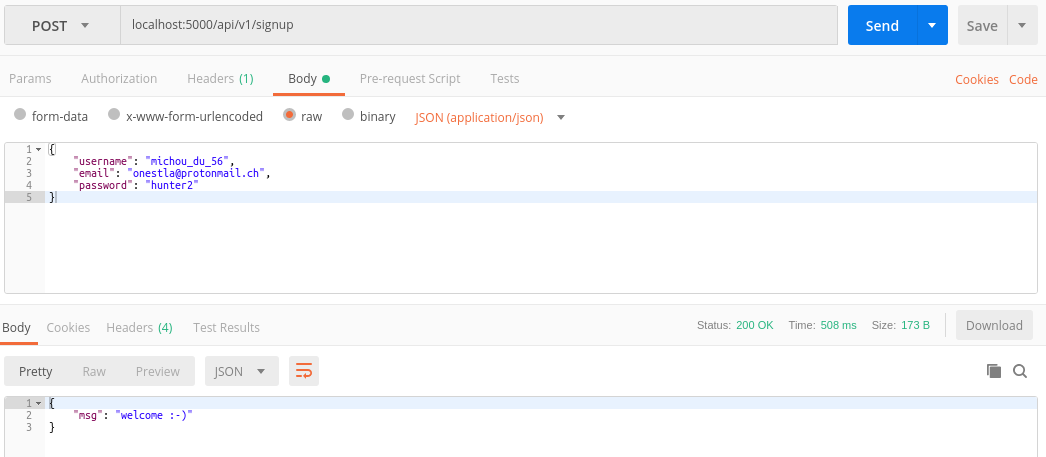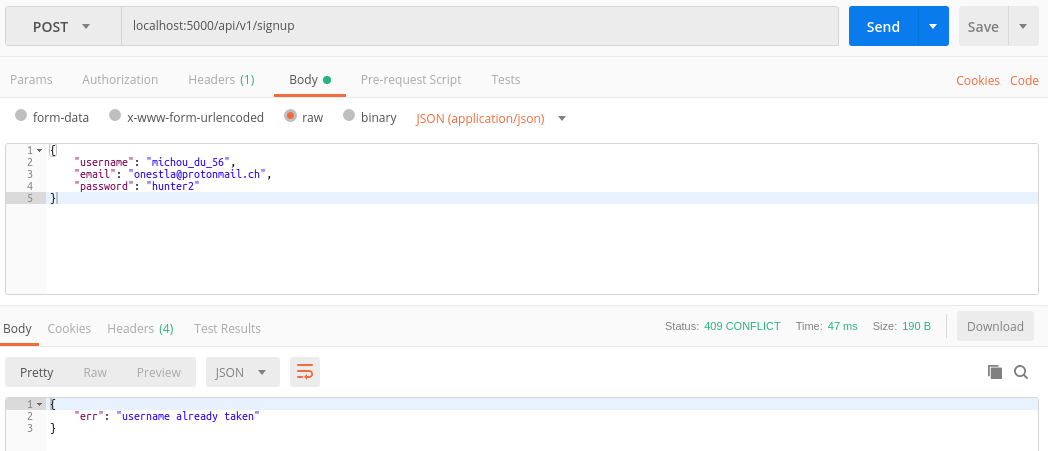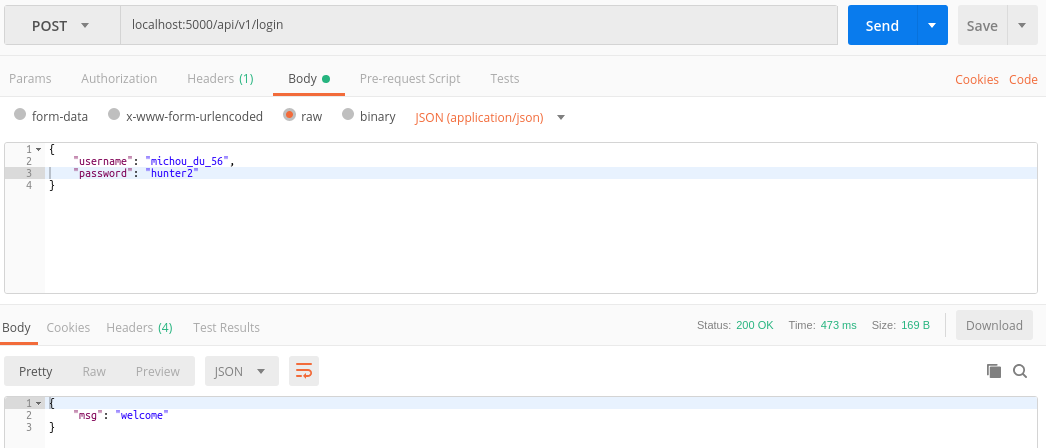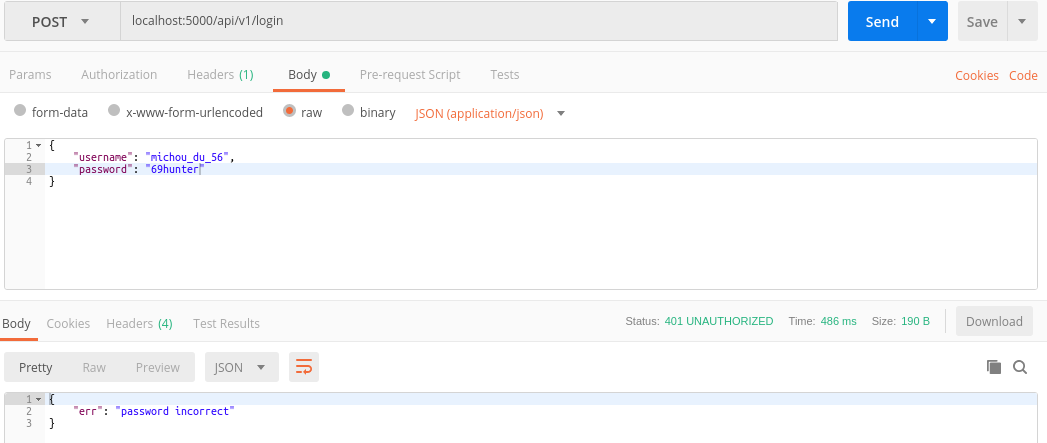Flask - Part 4
24 Sep 2018 · 6 min read
Introduction
This version_4 will show you how to create signup and login routes.
Setting up
To begin we will start from our previous version_3 app. If you don’t have it anymore, no worries, simply copy the reference code :
# assuming you're in flask_learning
cp -R flask_cybermooc/version_3 my_app_v4
cd my_app_v4
and initialize our venv :
# assuming you're in flask_learning/my_app_v4
virtualenv venv -p python3
source venv/bin/activate
# (venv)
pip install -r requirements.txt # install from the requirements.txt file
All set up ? let’s begin.
1 - Bcrypt
Because we will store passwords, we need to store them properly. (no md5 is not a proper way to store password). We will use the bcrypt algorithm.
1.1 - Installing bcrypt
In our venv, let’s install flask-bcrypt which contains bcrypt + a wrapper for flask.
And we don’t forget to update our requirements.txt.
# assuming you're in flask_learning/my_app_v4 (venv)
pip install flask-bcrypt
pip freeze > requirements.txt
1.2 - Adding bcrypt to our app
Now that bcrypt is installed, we need to tell our app to use bcrypt when it starts.
It’s a good idea to keep the Marshmallow object instance in a separate file, to avoid circular imports.
To do so, let’s create the marshmallow file :
# assuming you're in flask_learning/my_app_v4 (venv)
touch app/bcrypt.py
and add this code :
# bcrypt.py
from flask_bcrypt import Bcrypt
bc = Bcrypt()
In the application_factory __init__.py, let’s update our code :
# app/__init__.py
from flask import Flask
def create_app():
app = Flask(__name__)
from os import environ as env
app.config['SQLALCHEMY_DATABASE_URI'] = env.get('DATABASE_URL')
app.config['SQLALCHEMY_TRACK_MODIFICATIONS'] = False
from .database import db
db.init_app(app)
from .bcrypt import bc
bc.init_app(app)
from .cli import cli_init_app
cli_init_app(app)
from .api_v1 import api_v1_blueprint, root_blueprint
app.register_blueprint(root_blueprint)
app.register_blueprint(api_v1_blueprint)
return app
Bcrypt is now imported and initialized.
2 - Updating our model
In app/models/user.py we can now add some methods to use bcrypt.
# models/user.py
# http://docs.sqlalchemy.org/en/latest/orm/extensions/declarative/basic_use.html
from .base import Base
from ..bcrypt import bc
from ..database import db
class User(Base):
__tablename__ = 'users'
username = db.Column(db.String, nullable=False, unique=True)
email = db.Column(db.String, nullable=False, unique=True)
encrypted_password = db.Column(db.String, nullable=False)
def set_password(self, password):
self.encrypted_password = bc.generate_password_hash(password)
def verify_password(self, password):
return bc.check_password_hash(self.encrypted_password, password)
4 - Creating our routes
In app/api_v1, let’s create a file user.py for the routes of the user :
# assuming you're in flask_learning/my_app_v4 (venv)
touch app/api_v1/user.py
We import those routes in our module app/api_v1/__init__.py.
# app/api_v1/__init__.py
from flask import Blueprint
root_blueprint = Blueprint('api_v1', __name__)
api_v1_blueprint = Blueprint('api_v1', __name__, url_prefix='/api/v1')
# Import any endpoints here to make them available
from . import hello
from . import user
4.1 - Signup route
To signup, the route will receive a username, an email and a password.
In app/api_v1/user.py
# app/api_v1/user.py
from flask import (
jsonify, request
)
from . import api_v1_blueprint
from ..database import db
from ..models.user import User
@api_v1_blueprint.route('/signup', methods=['POST'])
def signup():
datas = request.get_json()
username = datas.get('username','')
if username is '':
return jsonify(error="username is empty"),422
email = datas.get('email','')
if email is '':
return jsonify(error="email is empty"),422
# we could verify that this email is valid
password = datas.get('password','')
if password is '':
return jsonify(error="password is empty"),422
if User.query.filter(User.username == username).first() is not None:
return jsonify(err="username already taken"), 409
if User.query.filter(User.email == email).first() is not None:
return jsonify(err="email already signed-up"), 409
new_user = User()
new_user.username = username
new_user.email = email
new_user.set_password(password)
db.session.add(new_user)
db.session.commit()
return jsonify(msg="welcome :-)"), 200
Explaining :
- line 15 : reading the json we received
- lines 17 to 26 : checking that the differents JSON fields are correct (not empty etc…)
- lines 27-28 : calling the controller to create the user
- line 29 : if the controller does not raise any exception, we can proceed
- lines 30-31 : return the error
4.1.1 - Adding the unit test
In our folder tests, let’s add a file test_2_signup_route.py : (we add a number to order the tests)
# tests/test_2_signup_route.py
def test_signup_empty_password(client):
# testing errors
empty_password = client.post("/api/v1/signup", json={
'username': 'testuser', 'password': '', 'email': 'test_user@mail.com'
})
assert empty_password.status_code == 422
def test_signup_empty_username(client):
empty_username = client.post("/api/v1/signup", json={
'username': '', 'password': 'test_user', 'email': 'test_user@mail.com'
})
assert empty_username.status_code == 422
def test_signup_empty_email(client):
empty_email = client.post("/api/v1/signup", json={
'username': 'testuser', 'password': 'test_user', 'email': ''
})
assert empty_email.status_code == 422
def test_signup_correct(client):
correct = client.post("/api/v1/signup", json={
'username': 'testuser', 'password': 'test_user', 'email': 'test_user@mail.com'
})
assert correct.status_code == 200
def test_signup_username_taken(client):
username_taken = client.post("/api/v1/signup", json={
'username': 'testuser', 'password': 'test_user', 'email': 'test_user@mail.com'
})
assert username_taken.status_code == 409
def test_signup_email_taken(client):
email_taken = client.post("/api/v1/signup", json={
'username': 'testuser', 'password': 'test_user', 'email': 'test_user@mail.com'
})
assert email_taken.status_code == 409

4.1.2 - Testing this signup route
Let’s run our app, initiate the database and test this route :-)
# assuming you're in flask_learning/my_app_v4 (venv)
flask reset-db
flask run
-
Postman :

Success, it’s working great :)
And if we try to signup again with the same username :

We got our error back. Great !
-
HTTPie :

Success, it’s working great :)
And if we try to signup again with the same username :

We got our error back. Great !
Perfect, our app is working great :)
A quick check inside the database to be sure the data is stored :

The password is encrypted and our user is there, no problem !
4.2 - Login
In app/api_v1/user.py, at the end of the file, let’s add our login route :
# app/api_v1/user.py
[...]
@api_v1_blueprint.route('/login', methods=['POST'])
def login():
datas = request.get_json()
username = datas.get('username','')
if username is '':
return jsonify(error="username is empty"),422
password = datas.get('password','')
if password is '':
return jsonify(error="password is empty"),422
user = User.query.filter(User.username == username).first()
if user is not None:
if user.verify_password(password):
return jsonify(msg="welcome"), 200
return jsonify(err="password incorrect"), 401
return jsonify(err="username incorrect"), 404
4.2.1 - Adding the unit test
In our folder tests, let’s add a file test_3_login_route.py : (we add a number to order the tests)
# tests/test_3_login_route.py
def test_empty_password(client):
# testing errors
empty_password = client.post("/api/v1/login", json={
'username': 'testuser', 'password': ''
})
assert empty_password.status_code == 422
def test_empty_username(client):
empty_username = client.post("/api/v1/login", json={
'username': '', 'password': 'test_user'
})
assert empty_username.status_code == 422
def test_correct(client):
correct = client.post("/api/v1/login", json={
'username': 'testuser', 'password': 'test_user'
})
assert correct.status_code == 200
def test_wrong_username(client):
wrong_username = client.post("/api/v1/login", json={
'username': 'testusernot', 'password': 'test_user'
})
assert wrong_username.status_code == 404
def test_wrong_password(client):
wrong_password = client.post("/api/v1/login", json={
'username': 'testuser', 'password': 'test_user_wrong'
})
assert wrong_password.status_code == 401

4.2.1 - Testing this login route
Let’s run our app :
# assuming you're in flask_learning/my_app_v4 (venv )
flask run
Postman:
Success :

Fail :

HTTPie:
Success :

Fail :

Conclusion
If you’re stuck or don’t understand something, feel free to drop me an email / dm on twitter / a comment below. You can also take a look at flask_learning/flask_cybermooc/version_4 to see the reference code. And use run.sh to launch it.
Otherwise, congratulations ! You just learned how to create two main routes “login” and “signup”. (well your users aren’t technically logged-in but still)
If you understood everything, in part 5 you will see how to use JSON Web Tokens, a cool way to authentify your users.
